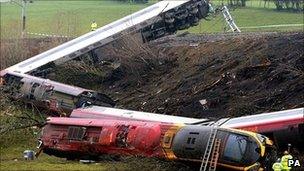Grayrigg crash: Train driver Iain Black 'could not stop'
- Published

Driver Iain Black broke his neck in the derailment
A driver has told an inquest he could not have stopped his train before it derailed at 95mph and plunged down an embankment, killing an elderly woman.
Iain Black, 50, of Dumbarton, who broke his neck in the 2007 crash at Grayrigg, Cumbria, said he had not seen the faulty points blamed for the incident.
But he said it would have been too late to stop the 300-tonne Virgin train even if he had seen the danger earlier.
Margaret Masson, 84, of Glasgow, was killed in the crash.
The train's eight carriages derailed and 86 passengers and two crew were also hurt.
'Thrown around cab'
Mr Black was giving evidence on the second day of the Kendal inquest into Mrs Masson's death.
He said it would have taken a train going at 95mph half a mile (800m) to come to a halt.
He said: "Although I did not see the points, you can only see 15ft (4.6m) in front of you. Had I noticed the points out of synch, I could not have stopped the train.
"With 300 tonnes of metal at 95mph it is going to go wherever it wants. I had no control.
"We stopped at 300m (984ft) that night because we were hitting stuff."
Mr Black said the Virgin Pendolino train had "leapt into the air" and he was thrown around the cab.
'Unsafe' points
He said an automatic braking system was triggered within seconds of the derailment, which happened on the West Coast Main Line near Kendal at 20:21 GMT on 23 February.
A Rail Accident Investigation Branch (RAIB) inquiry ruled the "immediate cause" of the crash was the train had gone over a "degraded and unsafe" set of points, known as Lambrigg 2B.

The train came off the tracks and careered down an embankment
RAIB accident investigator Simon Kay told the inquest an inspection of the track where the crash happened was due to take place five days before the crash but never took place.
He said four faults with the Lambrigg 2B points built up anytime between 7 January and 23 February, the day of the crash.
He said the first two faults had occurred by 12 February.
Mr Kay said: "There was a track inspection planned for 18 February which didn't take place."
Mrs Masson, known as Peggy, had got on the train at Preston, Lancashire, accompanied by her daughter Margaret Langley and son-in-law, Richard.
Keith Vernon, a track engineer for Network Rail, told the inquest he was on site and made a preliminary assessment that the cause was faulty points within two hours of the crash.
Mr Vernon walked the length of the track, with a torch, and focused on the Lambrigg 2B points.
He said: "The first thing was it was apparent there was some damage and something did not look right."
Mr Vernon took photos, which were shown to the jury, of broken brackets holding rails down, bolts not in their holes and stretcher bars, which keep rails a set distance apart, also missing.
The jury was told that when the crash happened the stretcher bars had deteriorated to the extent that when the train's left-hand wheels passed over the points they took the line veering right but the right-hand wheels stayed on the original line and did not switch to the right.
As a result, the left-hand wheels came off the rails.
Mr Vernon said he checked parts of the track which the train had passed over before reaching the points, but there was no damage along that part of the line.
He then said he arranged for the points to be covered with a tarpaulin to preserve evidence from the elements.
"The points should not have been in that state. There was defects throughout it," he said.
The hearing continues.
- Published24 October 2011
- Published22 July 2011